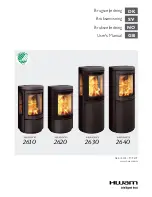
Vermont Castings • Aspen C3 Owner’s Manual_R5 • 2019 - ___ • 11/19
17
8390-950c
D. The Chimney System
Your Aspen C3 is designed to reduce creosote build-up
significantly. However, regular chimney inspection and
maintenance must still be performed. For safety, good stove
performance, and to protect your chimney and chimney
connector, inspect your chimney and chimney connector on
a regular schedule. Clean the system if necessary. Failure
to keep the chimney and connector system clean can result
in a serious chimney fire.
When wood is burned slowly, it produces tar, organic vapors
and moisture that combine to form creosote. The creosote
vapors condense in the relatively cool chimney flue of a slow-
burning fire. As a result, creosote residue accumulates on the
flue lining. When ignited, this creosote makes an extremely
hot fire within the flue system that can damage the chimney
and overheat adjacent combustible material. If a significant
layer of creosote has accumulated —1/8" (3 mm) or more
— it should be removed to reduce the risk of a chimney fire.
You can never be too safe. Contact your local fire authority
for information on what to do in the event of a chimney fire,
and have a clearly understood plan on how to handle one.
If you do experience a chimney fire, act promptly to:
• Close the damper and air control lever.
• Get everyone out of the house.
• Call the Fire Department.
Inspect the system every two weeks during the heating
season as part of a regular maintenance schedule. To inspect
the chimney, let the stove cool completely. Then, using a
mirror and a strong light, sight up through the flue collar into
the chimney flue. If you cannot inspect the flue system in this
fashion, the stove must be disconnected to provide better
viewing access.
Clean the chimney using a brush the same size and shape
as the flue liner. Flexible fiberglass rods are used to run the
brush up and down the liner, causing any deposits to fall
to the bottom of the chimney where they can be removed
through the clean-out door.
Clean the chimney connector by disconnecting the sections,
taking them outside, and removing any deposits with a stiff
wire brush. Reinstall the connector sections after cleaning,
being sure to secure the joints between individual sections
with sheet metal screws.
If you cannot inspect or clean the chimney yourself, contact a
professional chimney sweep or your local Vermont Castings
dealer.
WARNING
!
Inspect and Clean Chimney Frequently – Under
certain conditions of use, creosote buildup may occur
rapidly.
Unit Maintenance Schedule
-
The Stove
Daily:
• Ashes should be removed before they reach the bottom
of door. Check accumulation at least once a day.
• Keep the area around the stove clear of any combustible
materials such as wood, furniture or clothing.
Two Months:
• Check door handle to be sure it is working properly.
Gasketing becomes compressed after a period of time.
Adjust handle tightness if necessary.
• Check leg bolts; tighten if necessary.
Annual Spring Cleaning:
• Check gasketing for wear, and replace if necessary.
• Remove ashes from the firebox replace with a moisture
absorbing material (such as kitty litter) to keep the interior
of the stove dry.
• Touch up the black paint.
Chimney Connector
Two Weeks
• Inspect the chimney connector and chimney. Clean if
necessary.
Two Months:
• Inspect the chimney and chimney connector. Pay particular
attention to the horizontal runs of chimney connector, and
the elbows. Clean the system if necessary.
Annual Spring Cleaning:
• Disassemble the chimney connector and take it outdoors
for inspection and cleaning. Replace weak sections of
connector.
• Inspect the chimney for signs of deterioration. Repairs to
a masonry chimney should be made by a professional
mason. Replace damaged sections of prefabricated
chimney. Your local Vermont Castings dealer or a
chimney sweep can help determine when replacement
is necessary.
• Thoroughly clean the chimney.
CAUTION
!
BURN UNTREATED WOOD ONLY. OTHER MATERIALS
SUCH AS WOOD PRESERVATIVES, METALS, FOILS,
COAL, PLASTIC, GARBAGE, SULPHUR, OR OIL, MAY
DAMAGE THE CATALYST.








































